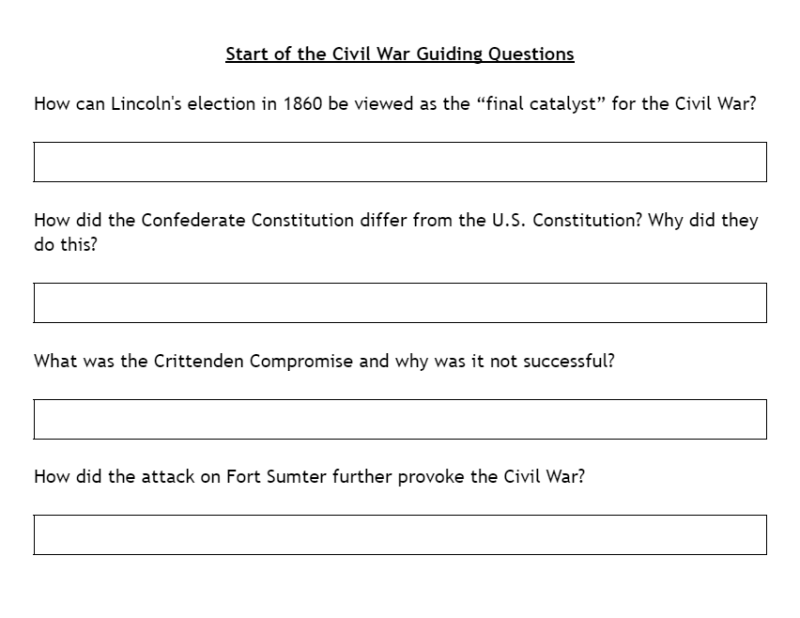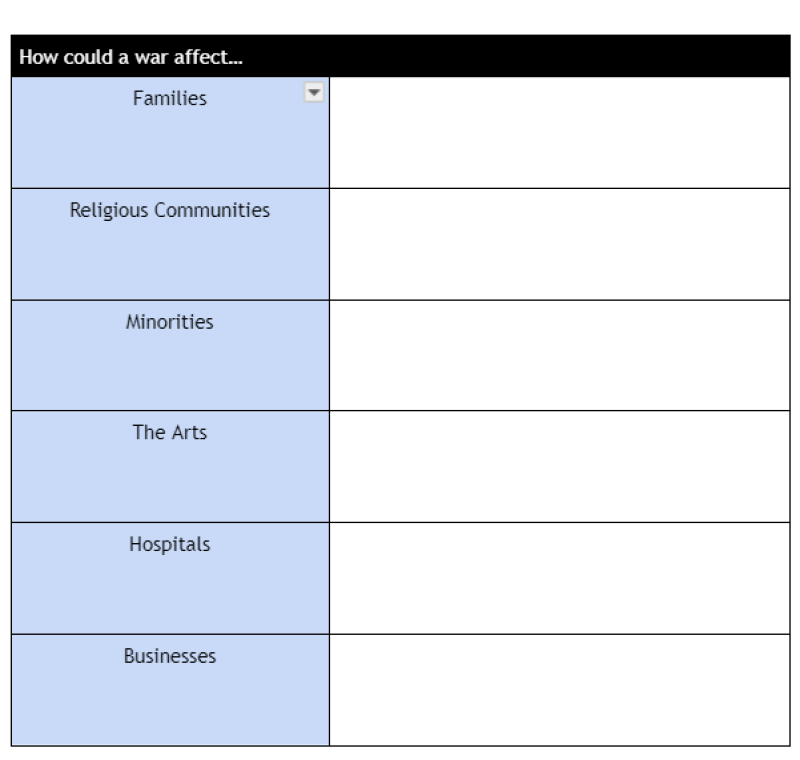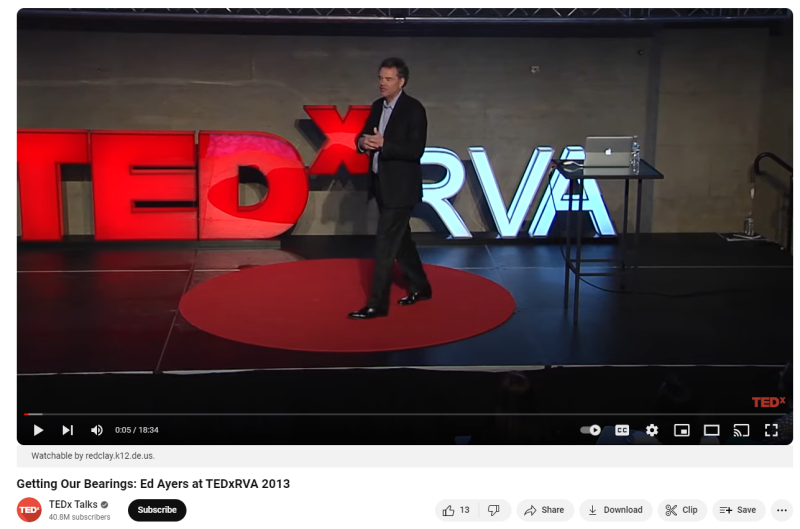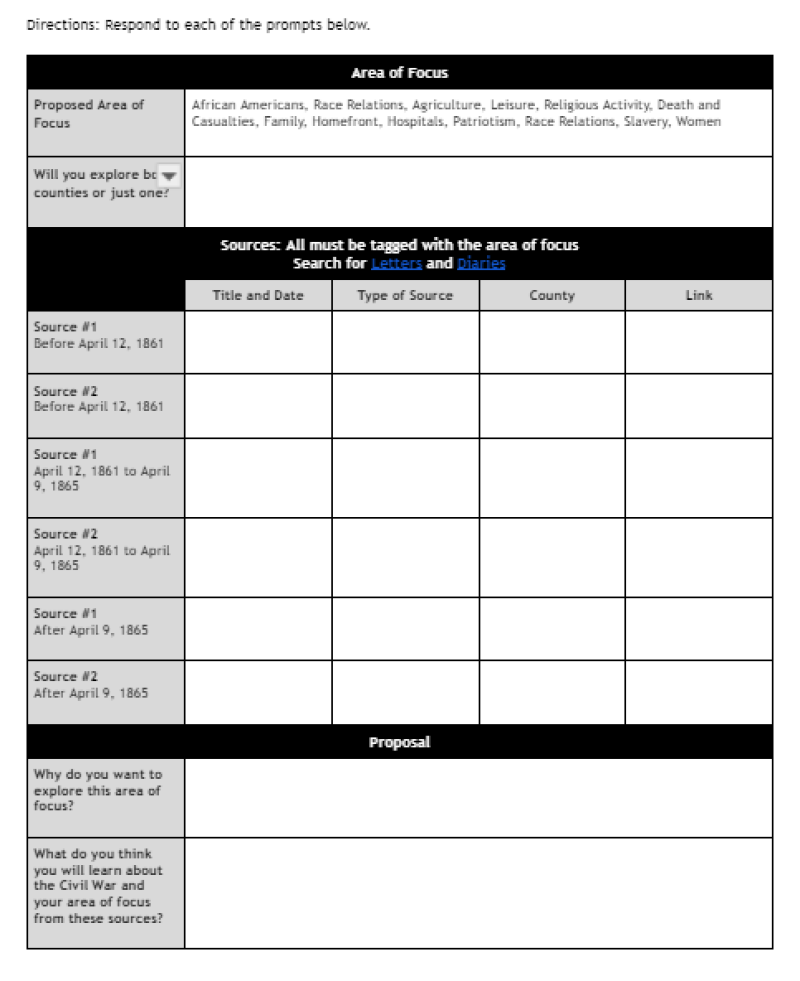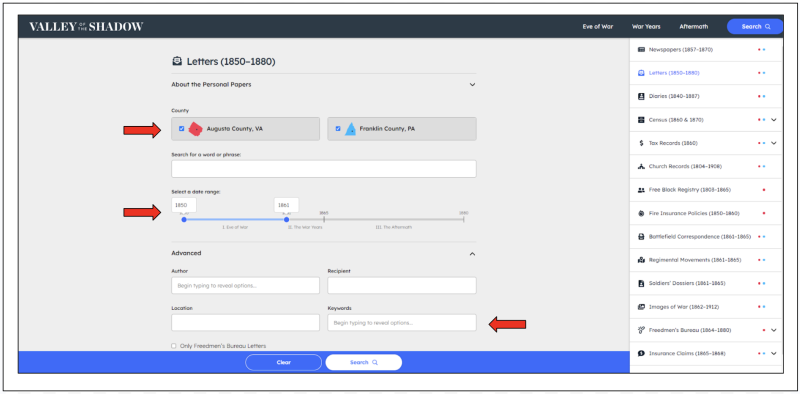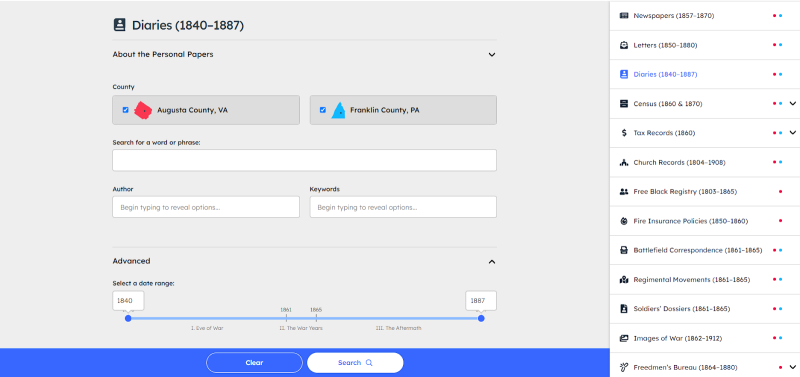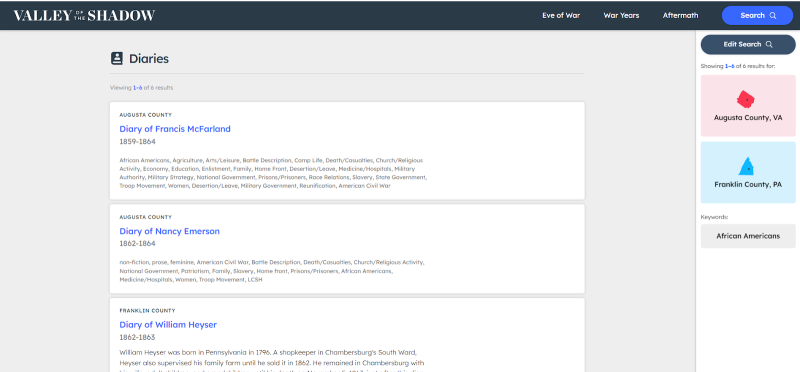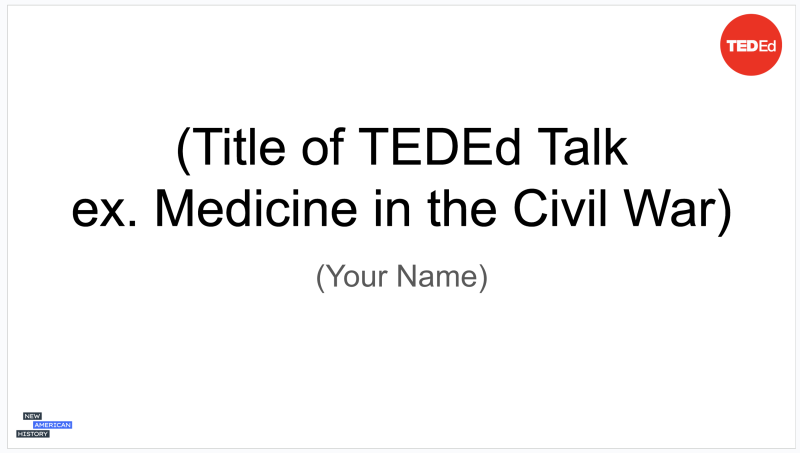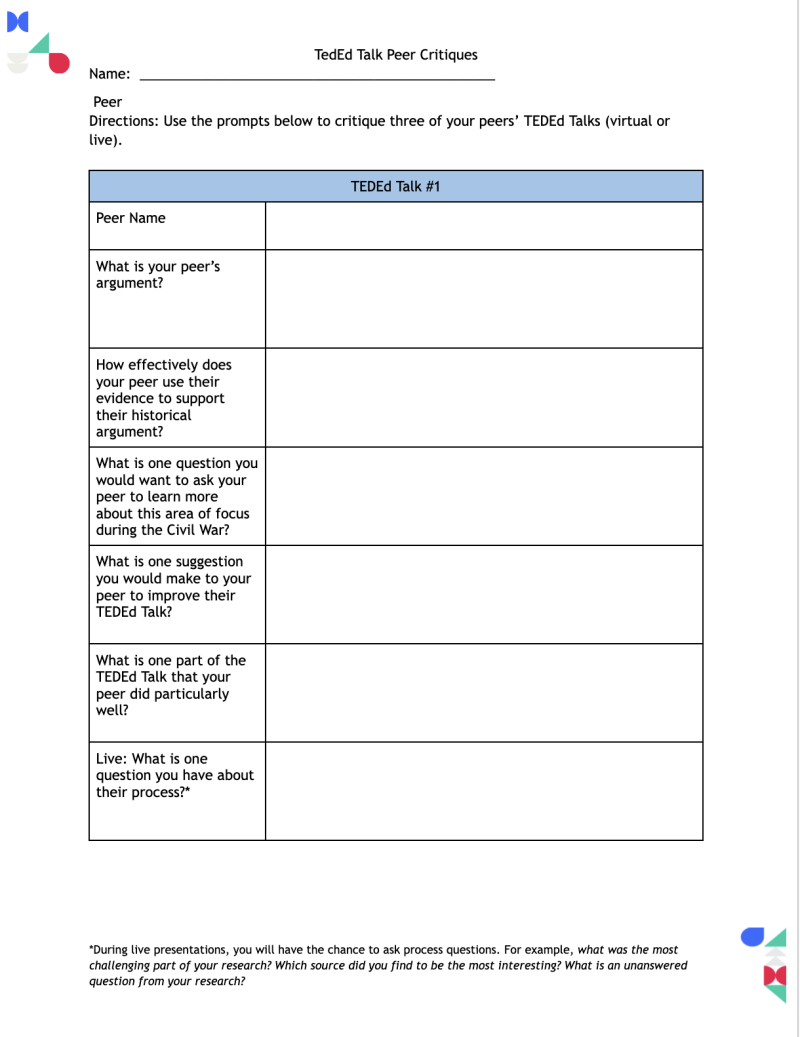This work by New American History is licensed under a Attribution-NonCommercial-ShareAlike 4.0 (CC BY-NC-SA 4.0) International License. Permissions beyond the scope of this license may be available at newamericanhistory.org.
The Valley of the Shadow: TEDEd Talks
View Student Version
Standards
C3 Framework:D1.1-4: Constructing Compelling QuestionsD1.5: Determining Helpful SourcesD2.His.1: ChronologyD2.His.2: Change and Continuity over TimeD2.His.3: Agency and ContextD2.His.4: Influencing PerspectivesD2.His.5: Context and PerspectiveD2.His.9: Primary and Secondary SourcesD2.His.11: SourcingD2.His.14: Cause and EffectD2.His.15: Long-Term CausesD2.His.16: Integrating Multiple PerspectivesD3.1: Corroborating SourcesD3.3: Developing ClaimsD3.4: Strengths of ClaimsD4.1: Constructing ArgumentD4.2: Structure of ArgumentD4.3: Presentation of ArgumentD4.4: Critiquing Claims and EvidenceD4.5: Critiquing ExplanationsD4.6: Understanding ProblemsD4.7: Action to Address ProblemsD4.8: Taking Community Action
National Council for Social Studies:Theme 2: Continuity and Change
National Geography Standards: APSkill 1: Developments and ProcessesSkill 2: Sourcing and SituationSource 3: Claims and Evidence in SourcesSkill 4: ContextualizationSkill 5 Making ConnectionSkill 6: Argumentation
EAD Framework
Teacher Tip: Think about what students should be able to KNOW, UNDERSTAND and DO at the conclusion of this learning experience. A brief exit pass or other formative assessment may be used to assess student understandings. Setting specific learning targets for the appropriate grade level and content area will increase student success.
Suggested Grade Levels: 6-8, 9-12
Suggested Timeframe: 10 class sessions, 45 minute class periods or 7 class sessions, 90-minute blocks
Suggested Materials: Internet access via laptop, tablet or mobile device
Key Vocabulary
Cite - quote (a passage, book, or author) as evidence for, or justification of, an argument or statement, especially in a scholarly work.
Civilian - a person who is not a member of an armed force or police; a person not engaged in hostilities.
Context/Contextualize- the setting in which a historical event, idea, or object takes place. In writing, historical context includes the social, economic, cultural, and political influences that shape your primary sources. Historical context helps you understand your topic fully.
Corroborate- to make connections between two or more sources of evidence, used for backing up an idea or a claim.
Critique - a careful judgment in which you give your opinion about the good and bad parts of something (such as a piece of writing or a work of art).
Secede - to withdraw formally from membership of a federal union, an alliance, or a political or religious organization.
Source - a person or a publication that supplies information to determine the perspective of an author.
Primary source - An original document or artifact created at the time of an event or by a person directly involved, providing firsthand evidence or eyewitness accounts.
Secondary source - A source that interprets, analyzes, or discusses primary sources, providing an interpretation or analysis of the events or people involved.
TED - is an American-Canadian non-profit media organization that posts international talks online for free distribution under the slogan "ideas worth spreading". It was founded in 1984 as a technology conference, and has been held annually since 1990. It covers almost all topics—from science to business to global issues—in more than 100 languages.
Read for Understanding
Teacher Tips:
New American History Learning Resources may be adapted to a variety of educational settings, including remote learning environments, face-to-face instruction, and blended learning.
If you are teaching remotely, consider using videoconferencing to provide opportunities for students to work in partners or small groups. Digital tools such as Google Docs and Google Slides may also be used for collaboration. Rewordify helps make a complex text more accessible for those reading at a lower Lexile level while still providing a greater depth of knowledge.
These Learning Resources use a variety of graphic organizers provided throughout the learning resource, and embedded Teacher Tips which do not appear in the student version of this learning resource. Videos from Khan Academy and TEDxRVA are included as exemplars and to provide context for students as they shape their own TEDEd Talk presentations. Close Reading strategies are encouraged as students interact with primary sources. Process questions are also linked for students and explained in the linked PDF.
Current scholarship acknowledges the historiography has traditionally referred to the “Union” in the American Civil War as “the northern states loyal to the United States government,” the fact is that the term “Union” always referred to all the states together, which clearly was not the situation at all. In light of this, the reader will discover that the word “Union” will be largely replaced by the more historically accurate “Federal Government” or “U.S. Government.” “Union forces” or “Union army” will largely be replaced by the terms “U.S. Army,” “Federals,” or “Federal Army.” Those states that formed a political and social alliance, even though not recognized by the Lincoln government, called themselves the “Confederacy” or the “Confederate States of America.” In these learning resources, we acknowledge that political alliance, albeit an alliance in rebellion, by allowing the use of the terms “Confederate,” “Confederacy,” “Confederate Army,” for ease of reference and flow of the narrative.
These Learning Resources follow a variation of the 5Es instructional model, and each section may be taught as a separate learning experience, or as part of a sequence of learning experiences. We provide each of our Learning Resources in multiple formats, including web-based and as an editable Google Doc for educators to teach and adapt selected learning experiences as they best suit the needs of your students and local curriculum. You may also wish to embed or remix them into a playlist for students working remotely or independently.
For Students:
During the American Civil War (1861-1865), Americans found their lives turned upside down as the nation burst apart. Using The Valley of the Shadow, you will explore perspectives from this era to determine how society was transformed. Your conclusions will be presented through a TEDEd Talk with your peers to provoke conversation about the effects of war on everyday life.
Engage:
How can war transform society?
The American Civil War was a conflict between the United States federal government, often referred to as “the Union,” and the Confederacy, a group of eleven southern states that seceded from the United States. The war was fought over an increasingly hostile debate about slavery and lasted from 1861 to 1865.
To better understand the start of the conflict, watch this video from Khan Academy, "Start of the Civil War. "
Your teacher may choose to provide this graphic organizer to help you organize your answers.
Teacher Tip: The teacher could play this video for the whole class or have students watch it at their own pace if students have one-to-one devices.
After watching the video, consider that the war would not only have affected soldiers and politicians, but the everyday experiences of civilians as well. With a partner, consider the effects of war on different groups of people as aspects of their everyday life. Use this next graphic organizer together to organize your ideas.
Teacher Tip: While debriefing this activity, ask students to consider ways that war can create both temporary and lasting change. For example, crops could be destroyed resulting in food shortages that might not be resolved until after a war. The teacher can also ask students to consider present day conflicts such as the War in Ukraine or the Gaza Strip for contemporary examples.
Your teacher may ask you to record your answers on an exit ticket.
Explore:
What aspects of society are affected by war?
During the previous activity, you considered the effects of war on various groups of people. Over the next few classes, you are going to explore how a specific aspect of American life was transformed by the Civil War, such as women, race relations, hospitals, etc.
After several classes of research, you will construct an argument to present in the form of a TEDEd Talk to peers. A TED Talk is a recorded public-speaking presentation that was originally given at the main TED (technology, entertainment and design) annual event or one of its many satellite events around the world. TEDx Talks are local versions of a TED Talk geared towards a local community audience. TEDEd talks are focused on a K12 educator and/or student audience. Below you can find an example of a TEDx Talk by Historian Ed Ayers titled “Getting Our Bearings.”
To ground your work in primary source material, you will be using “The Valley of the Shadow” a digital archive created by Ed Ayers and recently updated by New American History to explore primary source materials from before, during, and after the American Civil War era.
The Valley of the Shadow will have you exploring perspectives primarily from two communities in the Shenandoah Valley: Franklin County, Pennsylvania and Augusta County, Virginia.
To begin, view and make a copy of the TEDEd Talk Proposal.
Your first step will be to decide the area of focus. This will help you to find, organize, and interpret your sources and ideas. Try to pick something that is interesting to you! For example: explore a local history connection, or select one of the key figures or events you are most curious about.
Next, think about if you want to explore just one county or both. If you choose both counties, you may be able to compare experiences in the North and the South. On the other hand, an exploration of one county may help to better understand the unique perspectives of Americans in that place.
Important Note: As you look for sources, you may not be able to find sources for one or both counties that relate to your area of focus. If so, you may need to adjust which counties you choose to explore.
After that, you need to use The Valley of the Shadow to find six different letters or diary entries that connect to your area of focus. Note you must choose two from before April 12, 1861 (‘Before the War’), two must be between April 12, 1861 to April 9, 1865 (‘During the War’), and two must have been created after April 9, 1865 (‘After the War’). Through this you will be able to compare American experiences before, during, and after the American Civil War to determine historical change and continuity over time.
To find letters, click the link for Letters on the TEDEd Talk Proposal. Depending on your proposal, either select one or both counties at the top. Adjust the date range to find sources specifically for before, during or after the war, or leave it unchanged to see all available sources. Click the "Keywords" box and select your area of focus. Click “Search.”
On this page, The Valley of Shadow will show you all of the letters available based on your search criteria. To change what you searched for, click “Edit Search.” When you find a letter that is interesting, click it to open up the source.
Each letter contains a summary that provides context on the source, the original text, and a modified text with spelling edits. Skim the source and determine whether the source relates to your area of focus and offers a valuable perspective for your research. Add these sources to your proposal.
Searching for diaries is very similar. Again, depending on your proposal, either select one or both counties at the top. Adjust the date range to find sources specifically for before, during or after the war, or leave it unchanged to see all available sources. Click the Keywords box and select your area of focus. Click “Search.”
At this point, you will see a list of diaries based on your search criteria. Of note, some of these diaries will have entries before, during, and maybe after the time period you are looking for. Click a diary to open up its entries.
Like letters, diaries have the original and modified spelling texts available. As you will see diaries contain entries over the course of days, months, and even years. Skim the diary for entries that connect to your area of focus and fit the time frame you are looking for. Add them to your proposal.
Teacher Tip: Some of the entries in diaries can be very short. In that case, ask students to use several entries as one source.
After you have found six sources, answer the proposal questions at the bottom of the document and submit the entire proposal to your teacher.
Teacher Tip: Be sure to review each proposal. Make sure each source fits the designated time frame, and that they connect to the area of focus. This can be time intensive, but this will save time later in the process and will help to ensure that students are set up to be successful as they begin the analysis of their sources.
Your teacher may ask you to record your answers on an exit ticket.
Explain:
What can primary sources convey about wartime experiences?
At this point, it is time to begin exploring and interpreting the primary sources you identified for your research. To do this, you will utilize three different graphic organizers, one for each period of time: Before the War, During the War, and After the War.
Each graphic organizer will ask you to source, contextualize, close read, and corroborate the letters and/or diaries you found in the Valley of the Shadow. Follow each of the prompts and be sure to refer to and cite the text whenever possible.
At the end of each graphic organizer, you will be asked to reflect on what you learned about your area of focus from the sources. It is important to understand that you will not be able to learn everything about African Americans, hospitals, etc. during this time period from two sources. However, these sources should be able to convey specific experiences, and when you put them together, you can begin to form interpretations based on those perspectives.
Furthermore, the During the War graphic organizer will ask you to consider if anything changed from before the war. Similarly, the After the War graphic organizer will ask the same from during the war. As you work through these prompts, consider how the war is changing people’s experiences, and how the war’s conclusion could also alter Americans’ lives.
Teacher Tip: This is one of the more challenging aspects of the project, but also the most critical. This will directly inform the arguments that students make in the TED Talks. Challenge students to look critically at and think creatively about their evidence to form conclusions derived from their sources.
Your teacher may ask you to record your answers on an exit ticket.
Elaborate:
How can historical evidence be organized into a compelling argument?
Now that you have completed your research, it is time to begin interpreting your work through a TEDEd Talk. To do this, you will first need to write a script for your talk. Click this link to view and make a copy of the TEDEd Talk Script.
To write your script, respond to the prompts in the boxes. Some will ask you to finish sentences with starters, or to insert content into spaces with parenthesis. Throughout this, utilize your work from your Before the War, During the War, and After the War graphic organizers.
Teacher Tip: Feel free to adapt the template to best meet the needs of your students. You might want to only ask students to use three of the six sources. Alternatively, you could remove the sentence starters.
When you are ready to present your talk, either live or recorded, you will read from the boxes. It might be helpful to copy and paste all of the text in the boxes to a separate Google Doc that will be cleaner and easier to read.
Once your script is complete, it is time to make accompanying slides to provide a visual for your audience. Click here to view and make a copy of the TEDEd Talk Slides Template.
Using your script, modify the slides to fit your talk using the prompts. On Slide #7, you will see several notes to keep in mind, along with links to find visuals you can add. Slide #8 includes TEDEd Talk logos you may use to brand your slides. Be sure to delete Slides #7 and #8 after you are done. Remember that these slides will support your TEDEd Talk; they are not your TEDEd Talk!
At this point, you are ready to present. Be sure to practice reading your talk several times before you present or record.
Teacher Tip: Students can present their talks live in class to each other or they could record their lecture via any screen record program and submit. Live presentations require a significant investment in instructional time and coaching some students with particular needs, but can make this a more meaningful experience for students. That being said, either can work!
Your teacher may ask you to record your answers on an exit ticket.
Extend:
How do historical interpretations differ amongst historians?
Congratulations on finishing your TEDEd Talk! At this point, you will either be presenting your talk live to your class, or you will have recorded and submitted a screencast of your talk.
You and your peers all explored how the American Civil War transformed American society, and some of them likely explored the same area of focus as you. Now, you will listen to and/or watch some of your peers’ talks to better understand the American Civil War era and to look for similarities and differences among your interpretations. To do this, you are going to write a critique of three of their conclusions to identify strengths along with growth opportunities, or constructive suggestions, within their work.
Click here to view and make a copy of the TEDEd Peer Talk Critiques. For three of your peers’ TEDEd Talks, respond to the prompts with specific examples from the talk. If you are watching students give their talks live, add a process question at the bottom that you can ask. (For example: What was the most challenging part of your research? Which source did you find to be the most interesting? What is an unanswered question from your research?)
Teacher Tip: Think carefully about how you want to present some of the feedback in these critiques to students. Students need to learn to give and receive honest feedback on their work, but you may want to filter that feedback for them.
Your teacher may ask you to record your answers on an exit ticket.
Citations:
Army University Press, ed. Publisher’s Note on the use of Civil War Terms, April 2021. https://www.armyupress.army.mil/Portals/7/combat-studies-institute/publishers-note-on-use-of-civil-war-terms.pdf
Ayers, Edward L. “Getting Our Bearings: Ed Ayers at TEDxRVA 2013.” YouTube, July 19, 2013. https://youtu.be/_lQXdT4HT70?feature=shared
“Close Reading.” Bucks County Community College Library/Media, March 2019. https://www.bucks.edu/media/bcccmedialibrary/tutoring/documents/writingareahandoutrevision/literature/Close-Reading.pdf
“Start of the Civil War | The Civil War Era (1844-1877) | US History | Khan Academy.” YouTube, September 24, 2015. https://www.youtube.com/watch?v=Dl0RRDiG6O8
“TED (Conference)” Wikipedia, accessed August 2024, https://en.wikipedia.org/wiki/TED_(conference)
Valley of the Shadow: Two Communities in the American Civil War, New American History. http://valley.newamericanhistory.org
Valley of the Shadow: Two Communities in the American Civil War, University of Virginia Library. http://valley.vcdh.virginia.edu/govdoc/popcensus.html
View this Learning Resource as a Google Doc


